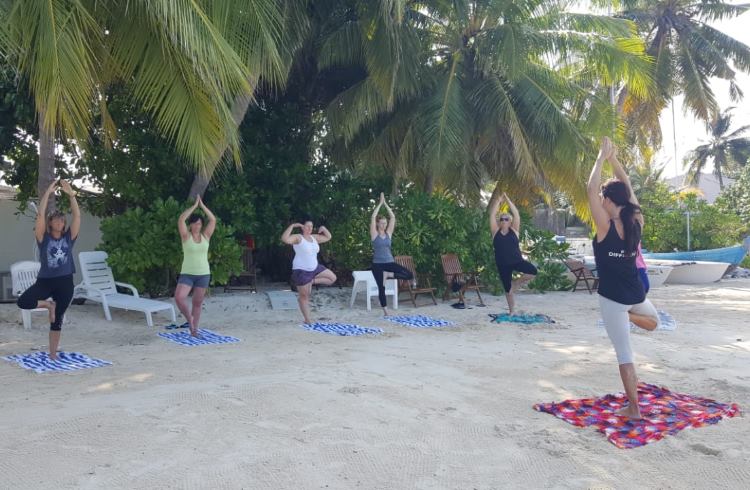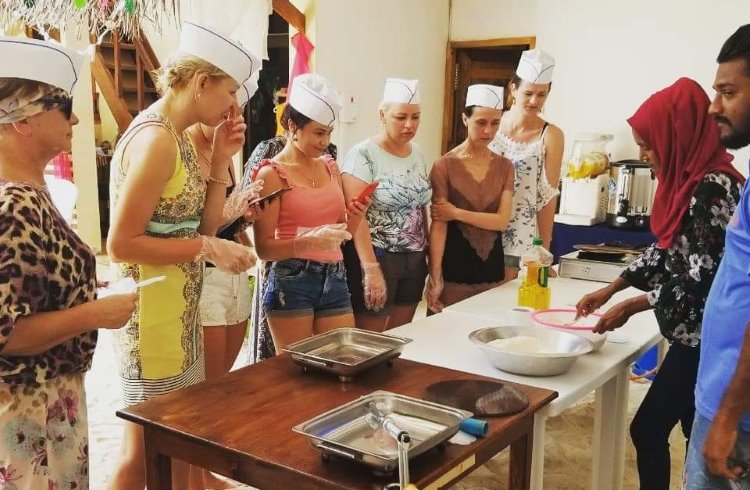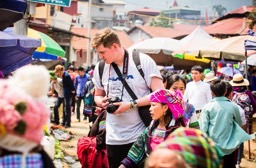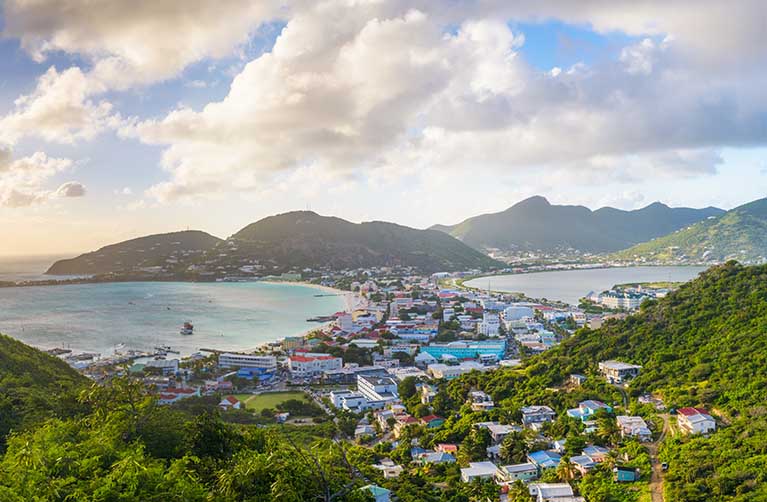Maldives on a Budget: Affordable, Community-Based Travel
There's more to the Maldives than expensive resorts and honeymooners. Affordable guesthouses are offering travelers a chance to experience the local culture in ways they never could before. Nomad and former Maldives resident Sarah shares her insights.
 Photo © Sarah Harvey
Photo © Sarah Harvey
The air is thick with humidity, and the stars this close to the equator are so huge and bright they seem near enough to touch. I’m trying not to get stuck to my white plastic chair on this typically warm Maldivian evening. The excitement in the crowd surrounding me is palpable. Almost all of Kamadhoo Island’s 495 residents have turned out tonight, and hundreds more have sailed to this inhabited island in Baa Atoll from rival islands for a bodu beru (big drum) contest. The Voice has nothing on what’s about to happen.
About 15 men stroll on stage in crisp white shirts paired with black-and-white striped sarongs. Five of them are carrying bodu berus made from goatskin and coconut wood painted with glossy black, red, and gold stripes. A few hold bells and one grasps an onugandu (small piece of bamboo with grooves cut into it, which makes a raspy sound when scraped). The beat starts slowly, and the lead singer begins chanting in Dhivehi (and sometimes nonsense words) to the rhythm, gradually building up to a frantic crescendo. Songs of heroism, love stories, and satire punctuate the night air. It’s hypnotic, for performers and audience members. The beats pulse through us as they clap and pound their feet on the ground. It’s impossible to not join in.
Performing bodu beru is known as “vibrating the island” in Dhivehi, the traditional language of the Maldives. I’m lucky to be one of the only foreign faces here, where a tin-roofed stage stands on the gritty coral by the harbor. But just 12 years ago, being here would have been almost impossible for an outsider. Community tourism wasn’t legalized in the Maldives until 2009.
The new law permits locals to open guesthouses, giving them access to tourism dollars. Previously, travelers couldn’t mix with the majority of Maldivians because they were only allowed to stay at resorts on private islands, totally cut off from the community.
- Organic cultural immersions in the Maldives
- Discovering Rasdhoo Island
- Local laws, rules, and cultural awareness
- Discovering the Maldives through food
- Support the local crafts
- Trip notes
Organic cultural immersions in the Maldives
As guesthouses are located on inhabited islands, guests are fully immersed in the unique Maldivian culture. There are no indigenous people in the Maldives – the population is descended from fishermen, traders, shipwreck survivors, and pirates from Africa, India, Sri Lanka, the Middle East, Malaysia, and China. Today, you can catch glimpses of its heritage through interactions with the community, such as catching a village bodu beru performance (which has strong West African influences) or discovering an artisan making lacquerware (Chinese origins).
There are hundreds of guesthouses to choose from, from as little as US $50/night, with Maafushi, Thulusdhoo, and Guraidhoo among the most popular islands. Maafushi has the most guesthouses if you’re into socializing. Thulusdhoo is a super surfing spot. Guraidhoo has easy access to the main airport. Hulhumale is popular, but feels very suburban, as it’s an extension of the airport island. To get away from it all, consider a smaller island, like Rasdhoo Island in Rasdhoo Atoll, a popular spot for divers due to its proximity to Hammerhead Point.
Discovering Rasdhoo Island
The island looks uninhabited when you approach by speedboat, but there are 75 homes hidden behind the lush coconut trees. It has the same turquoise waters as the resorts, plus two sandbanks. But a guesthouse here, such as BrickWood Rasdhoo, costs just US $55-95 per night, compared to the US $300 you’d pay for a room of this quality at a resort. All six contemporary rooms merge traditional elements such as coral walls with resort-style luxury design.

BrickWood Manager, Mohamed Shaheen, says: “We want our guests to go home with as many cultural insights as they can get. That’s the advantage of an inhabited island. You spend time with the inhabitants and get an insight into everyday life with local artist workshops, Maldivian games, and Maldivian cooking classes.”
Etiquette tip: alhough it’s possible to bag a guesthouse room for just under $50, the Maldives is an Upper Middle Income Country with a higher cost of living. Tourism professionals urge visitors not to try to barter for a lower rate than $50 because it harms the local economy.
Local laws, rules, and cultural awareness
Because the Maldives is a moderate Muslim nation striving to preserve its culture, visitors need a certain amount of cultural awareness when mixing with locals. It’s illegal to wear skimpy swimwear (bikinis/one-piece) on inhabited islands, but board shorts and a rash vest are fine. Women should cover shoulders and chest out of respect for the islanders’ conservative sensibilities. Many guesthouses offer private beaches, such as the 98ft (30m) beach at Rasdhoo, where skin-baring swimwear is allowed. Some guesthouses also offer trips to sandbanks or have private sundecks. Alcohol is illegal on inhabited islands, but guesthouses offer cheap day passes (US $60) to resorts so you can enjoy sundowners.
The rules may seem strict, but Maldivians are extremely welcoming and curious. They’ll often call to you, wanting to know where you’re from, while they’re smoking a hookah or reclining in a joali hammock-chair under the shade of a breadfruit tree.
Discovering the Maldives through food
One of the best ways to get to know a country is through its food. Many guesthouses offer cooking workshops led by local women (which also helps women earn a small income – many families frown upon women working at resorts). Most of the food is grown locally in contrast to the Japanese Wagyu beef and Norwegian salmon flown in by resorts at a greater cost to the environment.

A popular local dish is mas huni, a breakfast made from tuna, egg, onion, chili, and lime, and served with roshi (local flatbread). Once you've got your head around eating tuna for breakfast, you'll be addicted. It's light, healthy, and very Maldivian (tuna is the main export and fishing is the second biggest economy after tourism).
“It’s all mixed up in traditional Maldivian style, using the hands,” explains Shaheen “There are different varieties, including a vegetarian version with local pumpkin.”
Support the local crafts
Lacquerware is one of the most traditional artforms here. Unlike items made from seashells, which harm the ecosystem, it’s an excellent eco-friendly souvenir, made from sustainable coconut wood. Since the Maldives is on the frontline of climate change (most land is 4ft/1.2m above sea level), any steps you take to help the environment are welcome. Gifts such as lacquerware also help keep an ancient craft alive.
The finest lacquerware in the Maldives is hand-crafted in Baa Atoll. The atoll is also so remarkable for its marine biodiversity that it’s a UNESCO World Biosphere Reserve. Siraaj Mohamed recently built Atholhu Residence, an affordable private villa, on the tiny Baa Atoll island of Fehendhoo.
“Guesthouses like mine are four-star, the only difference between this and a resort is it’s so much cheaper, and you don’t get alcohol,” explains Siraaj. “You can fish right off the beach (which isn’t allowed at resorts), take a canoe to find mantas, paddleboard in the lagoon, and meet locals,” he adds.
Take a trip to neighboring Thulhaadhoo, the island best-known for its lacquerware, to watch local craftsmen shape coconut wood into bowls and vases, applying layers of black, red, and gold paint and polishing it with coconut leaves until it gleams brighter than the Maldivian sun. Centuries of history in the palm of a hand.
Trip notes
Velana International Airport is the main hub. Resort transfers cost US $200-700, but the (slower) public ferry network has tickets from US $3. Sit on the roof for the best views, but sunscreen up! You can book a scheduled public or private speedboat transfer via your guesthouse or online agents such as Atoll Transfer if it’s 1-3 hours away (US $60-100).
USD is accepted as currency alongside the Maldivian Rufiyaa (MVR).
The best time to visit is November-April. Expect sunny days, with an average annual temperature of 86°F (30°C). If you take a gamble on (possible) rain during low season, you could save 30-60%.
Pack light clothes but remember cover-ups such as sarongs so as not to offend islanders. Bring mosquito repellent, and buy a plug-in mosquito killer from a local shop for your room (US $3-5). Mosquito nets aren’t used here, and you won’t find any hooks to hang yours up.
All inhabited islands have a local café. Expect fish curries with roshi, plentiful pasta dishes, sandwiches, and burgers. Try a “tea house” for delicious “short eats” (Maldivian tapas), normally made of deep-fried fish and coconut. Village stores sell basic snacks.
Related articles
Simple and flexible travel insurance
You can buy at home or while traveling, and claim online from anywhere in the world. With 150+ adventure activities covered and 24/7 emergency assistance.
Get a quote

1 Comment
It all sounds like a great idea. I have been to one of the resorts in the Maldives and was sort of uncomfortable that what was being offered to me was all being flown in from around the world. I love the idea of cookery classes using local ingredients.